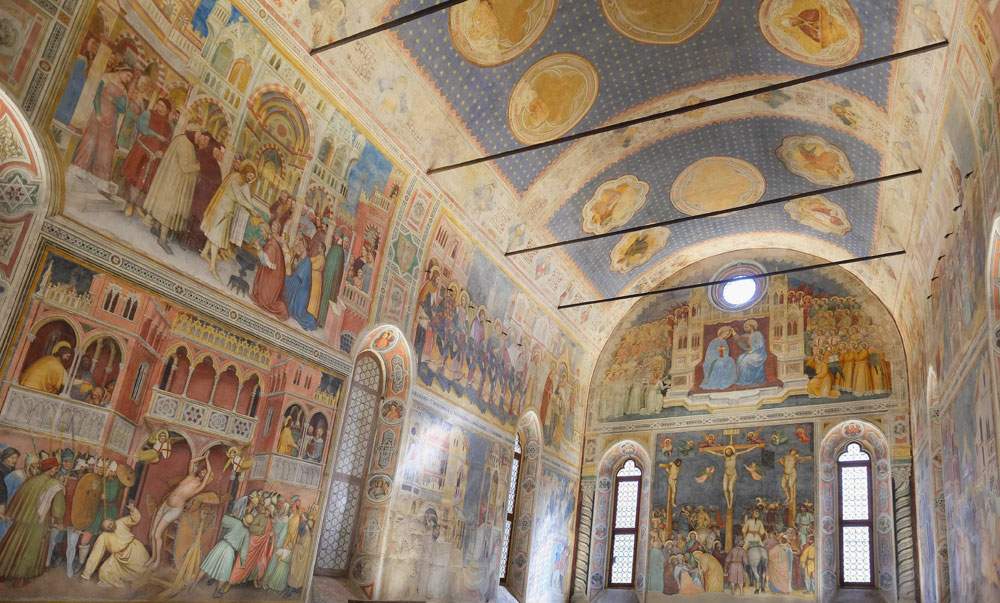Thanks to an innovative new lighting system, there will be a new perception of the 14th-century frescoes by Altichiero da Zevio in theOratory of San Giorgio, “the Scrovegni chapel at the other end of the 14th century” overlooking the parvis of the Basilica del Santo in Padua. Indeed, the “perceptive restoration” of the Oratory promoted by the Veneranda Arca di S. Antonio with the support of the Fondazione Cassa di Risparmio di Padova e Rovigo and iGuzzini illuminazione has been completed.
The building was commissioned as a family burial chapel by Raimondino Lupi di Soragna, a warrior and diplomat in the service of the Carraresi seigniory; construction work began in 1377 and was completed in 1384 with the creation of the fresco cycle by Altichiero da Zevio. The frescoes are a valuable testimony to theimpact of Giotto ’s painting in Padua and in the century of the Carraresi: Altichiero had as his point of reference Giotto’s undertaking in the Scrovegni Chapel and like it culminates in a starry sky on which stand clipei depicting sacred figures. On the counterfaçade are painted the stories of the birth of Jesus(Birth, Adoration of the Magi, Flight into Egypt, Presentation in the Temple), on the altar wall the great Crucifixion and, above, theCoronation of the Virgin. On the long walls are episodes from the history of St. George, St. Catherine of Alexandria, and St. Lucy. On the left wall ample space is given to the votive scene in which Rinaldino Lupi and his consort Matilde, parents of the patron, followed by other members of the family in military garb, kneel to the Virgin, introduced by St. George and in the presence of numerous saints. In the center of the oratory stood the complex architectural-sculptural structure of the founder’s funeral ark, whose stone tomb is still preserved. Brought to light in 1837, the frescoes underwent major restoration between 1995 and 1997, and now visitors can admire them with a new perception.
The previous lighting, with visual clutter that created disturbance for an adequate perception of the frescoes, has been replaced by a system that integrates perfectly with the architecture, ensuring an effect of perfect homogeneity of light. Laser Blade recessed fixtures illuminate the barrel ceilings of the Oratory, while Palco and Robin projectors enhance its shorter walls and the altar, respectively; finally, a special product illuminates the side walls in a grazing manner. All the fixtures, installed on a track that runs along the perimeter wooden structure, have a color temperature of 3000K and a color rendering index of 97 to ensure high visual comfort and enhance the color richness of the frescoes. The entire lighting system is also manageable via the Quick BLE control system and a Bluetooth push-button panel.
“The realization of this project allows the Oratory of St. George to be the first of the sites participating in the UNESCO candidacy to adopt a lighting system inspired by that of the Scrovegni Chapel, helping to revive the idea of a shared lighting system for the sites involved, enhancing the aspect of coherence, quality, cohesion, and uniqueness as indicators of excellence,” said Emanuele Tessari, Chief President of the Venerable Ark of St. Anthony. “I therefore want to thank the Fondazione Cassa di Risparmio di Padova e Rovigo and iGuzzini illuminazione for their contribution. The extraordinary result of this work has also convinced us to carry out, directly and through the search for new sponsors, the ”perceptive restoration“ also of the other two fresco cycles in the Basilica that are participating in the UNESCO Candidacy: the Chapel of St. James, with works by Altichiero da Zevio, and the frescoes by Giusto de’ Menabuoi in the Chapel of Blessed Luca Belludi. Among the objectives of the Venerable Ark of St. Anthony is the promotion of cultural initiatives aimed at increasing opportunities for exchange between the Basilica and the city and between the Basilica and the rest of the world. Any concrete act that shows the city’s interest in the candidate sites, therefore, becomes an important indicator of the involvement of the whole community.”
Image: Altichiero da Zevio’s frescoes in the Oratory of San Giorgio in Padua. Ph.Credit Antonio Bortolami
 |
| Padua, 14th-century frescoes in St. George's Oratory shine in new light |
Warning: the translation into English of the original Italian article was created using automatic tools. We undertake to review all articles, but we do not guarantee the total absence of inaccuracies in the translation due to the program. You can find the original by clicking on the ITA button. If you find any mistake,please contact us.